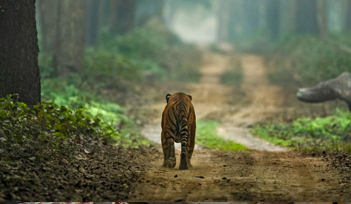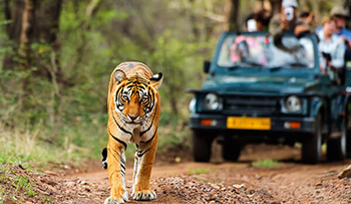Home > Rhinoceros of Dudhwa National Park
Rhinoceros of Dudhwa National Park
The word 'Rhinoceros' is a combination of two Greek words - Rhino means nose and Keros means horn, that is a creature with horn on its nose.
Fossils discovered in many locations in North America, Europe, Africa and Asia confirms the first appearance of Rhino like animals i.e. Hyrachus on earth 60-40 million years ago. Its size was somewhat between that of a large dog and a horse. After 20-30 million years Hyrachus developed long slender legs with three toes on each foot and were known as Hyracodon. A lot more changes occurred in the Rhino throughout the period. Around one million year ago the Rhino like animal was called as Coelodonta, i.e. wooly rhinoceros.
Geological upheavals, climatic changes as well as biotic factors have ensured that most of the several dozen genera of the family Rhinocerotidae have become extinct. At present there are only five species in the world, two in Southern & Eastern Africa and three in tropical Asia. All five extant species today are also threatened with extinction due to interference by man. Due to its present status it has been included in the Appendix-I of CITES and Indian Rhino has been included in the schedule-I of Wildlife (Protection) Act, 1972.
- The African white or Squaretipped Rhinoceros (Caratotherium simum) Average weight is 3.6 tons and average shoulder height is 198 cm. The actual colour is grey. White word comes from the African word 'Weit" i.e. wide square mouth of the animal. It is the biggest of all the five Rhinos and also the second largest terrestrial mammal after the elephant. It has two horns on its nose, anterior one larger than the posterion. Only male has horns.
- The African Black Rhino (Diceros bicornis) Average weight 1.5 to 2.0 tons and shoulder height is 160 to 170 cm. It has two horns. It is the largest member of Rhinos found out of the five species.
- The Asiatic two Horned or Sumatran Rhino (Dicerorhinussumatrensis) The average weight is 0.85 to 1.0 ton and shoulder height 120 to 130 cm. It is the smallest of the five, and population is around 100. Being two horned it forms a link between Asiatic and African Rhino. It is the only Rhino, which has hair on its body.
- The lesser One Horned or Javan Rhino (Rhinoceros sondaicus) The average weight is around 1.5 to 1.3 tons and shoulder height is 160-175 cm. It has a single horn.
- The Great Indian One Horned Rhinoceros (Rhinoceros unicornis) The average weight is 2.0 tons and shoulder height 170-180 cm. Male & female both has horn and also of almost equal length. The horn length is 35- 40 cm.
Fossil remnants show that all the 3 species of Asiatic Rhino were to be found in India in the prehistoric past. None of the five extant species has upper canine. Cutting teeth or incisor is reduced. Asiatic species have heavy folds on their body in comparison to African ones. Though the skin of GIOH Rhino like the others is unusually thick & seems to be impenetrable, in reality it is quite soft and is easily cut by a knife or penetrated. Rhino's vision is extremely poor but sense of hearing and smell are acute. In Indian Rhinos it is very difficult to distinguish a male from a female, but the female skull is slightly thinner and base of the horn narrower and horn slimmer. The horn of rhino is not a true horn because it does not have a core of bone. Instead it is a compact mass of keratin fibres, not fixed to the skull, but resting on a bony cushion. The Indian Rhinos can attain a speed of 48-50 km/hr whereas an elephant can attain only 32 km/hr.
Indian Rhino (IR) is basically a grazer. It loves wallowing i.e. mud bathing during the hotter part of the day to lower its body temperature and to obtain relief from ectoparasites. Whereas other Rhinos are browser i.e. more adapted to live in woodlands. IR is restricted to the alluvial plains of mega Rivers such as Indus, Ganges, Yamuna and Bra mhaputra. It remained confined to the Northern half of the Indian subcontinent. It is of course also found in plain, marshy, riverine terrains at a higher elevation such as Chitwan in Nepal and Bhutan on the foothills of Eastern Himalaya i.e. Manas & Jaldapara.
In case of IR mating is the only activity that brings the male & female together or else IR is a solitary animal. There is no fixed season for mating. The average age of sexual maturity of female rhino is 8-9 years and for male 9-10 years. Female IR is polyestrous, with an estrus cycle of 46- 48 days, and remains for 2-3 days. When a female rhino comes to estrus it urinates frequently and runs to and fro and shows an air of restlessness, intake of food becomes low. A male will detect the pheromone in urine of the female and will be aroused for mating. A pregnant detected only at least 6 months after conception, when there is a swelling of her underbelly. Before delivery her stomach almost touches the ground. Gestation period for IR is 16-18 months. Single birth is a rule and give birth to fully developed ones i.e. precocial. Delivery is anterior i.e. head and forelegs comes out first. The newborn calf is completely red in colour & after 3-4 weeks changes into greyish black colour. Average lying out period is one day. The average intercalving period is 42 months. As the case in content of rhino milk is low, the calf has to suckle every half hour or so. Average suckling period for rhinos is 18 months. At the age of 4 years, rhino calf attains relative physical maturity and afterwards the growth is slow.
Community latrine is an unique activity of rhinos. Rhinos defecate at single place, in higher terrains to avoid unhygienic condition and water pollution. IRs does not go to a particular place to defecate. Whenever it feet a urge, but it does set an urge whenever it smells a dung heap.
Indian Rhino is an indicator species of the wetland ecosystem, are of the richest & most productive ecosystems of the world. By studying the rhino we can learn a lot about the wetland ecosystem. Study of rhino requires a lot more conservation, protection &, awareness about rhino.
Rhino Reintroduction Programme
The range of the Greater Indian Rhinoceros (Rhinoceros unicornis) once spanned the flood plains of the Indus, Ganges and Brahmaputra rivers. Historical texts such as Babur-nama record the present Indo-Burmese border in the East. Hunting and habitat destruction in the last couple of centuries however finished off the rhino in much of this range, the only pockets left being in North-East India and Nepal.
In August 1979. the Asian Rhino Specialist Group of !he IUCN Survival Service Commission (now known as the Species Survival Commission) emphasised the need for continuous effort in protection and monitoring of the species, adding that "steps must been envisaged to establish additional viable population units in suitable areas, preferably in the rhinos former distribution range".
Following up on these recommendation of the Asian Rhino Specialist Group, the Wildife Status Evaluation Committee of the Indian Board For Wildlife appointed, in 1979, A sub-committee to consider alternative areas for rhino translocation. Of the various areas considered by this sub-committee, Dudhwa Naational Park was thought to be the most promising because of the similarities of habitat to that of Kaziranga National Park, the fact that rhinos had been recorded in this area till the last century and the adequacy of the protection available. The suitability was confirmed by Prof. Schenkel, Chairperson of the AsianRhino Specialist Group and was further supported by vegetation studies by the Botanical Survey of India which revealed the presence of several preferred food (grass) species of rhino.
Once the decision to establish a rhino population in Dudhwa was taken, considerable groundwork was needed to make this a reality. The area selected as the Rhino Reintroduction Area (RRA) is in South Sonaripur Range. It comprises of the entire Kakraha Block and a part of Chhota Palia Block. The RRA has as many as nine permanent large and small lakes. The chain of these lakes lies along the damar sal and grassland ecotone. These lakes and two nallahs, Andhra and Chabakwa are old courses of the river Suheli. During monsoon, major parts of the grasslands get flooded. Running water can be seen in the two nallahs and chain of lakes, while the other areas have up to 4 feet of standing water. The area of 27 sq.km. comprising some damar sal forests (20%) and grasslands (80%) was initially enclosed by a three-strand electric fence. A 9 km. stretch of Park boundary was additionally protected against accidental escape by the construction of a rhino-proof trench outside the electric fence. Holding stockades for the new arrivals were built within the fenced zone. Field staff was sent to Assam for training in rhino management.
During March-April 1984 six rhinos were captured near Pobitara Wildlife Sanctuary in Assam. Of these one died at Guwahati Zoo and the rest, two males and three females were translocated to Dudhwa. At Dudhwa, the animals were kept in stockades and then released. Of the five animals, one female died of stressful abortion before she could be released. The first batch of animals was released in Dudhwa on 20.4.1984. The large male was held back until the others had settled and released after radio collaring a few days later. Another female died on July 31, 1984 after a bid to tranquilise her to treat a wound. With only one female and two males left, an urgent need was felt to translocate some more rhinos. The collaboration of the Government of Nepal was obtained in the exchange of four young adult female rhinos for sixteen elephants. The rhinos captured from near Chitwan National Park in Nepal arrived in Dudhwa in April 1985. Thus these seven rhinos, two males and five females made up the seed population.
The first evidence of breeding in the reintroduced population was detected under unfortunate circumstances when remains of a newly born calf was discovered in a patch of tall grass in August 1987. The first successful calving occurred in early 1989. This was followed by three more calves in the same year.
MONITORING
The rhino population is monitored daily from elephant back. Presently four elephants are engaged in this work.
The mahawats and staff scan the area for rhinos and report their observations which are recorded in a register. The monitoring of the re-introduction project is done from two places that is Salukapur & Base camp. Daily reports are sent to Range Head Quarters and office of Deputy Director at Palia.
FUTURE PROGRAMME
- Introduction of New Blood Stock to address the problems of inbreeding.
- More intensive habitat management activities in the RRA.
- Strength ing of the Solar Powered fencing in RRA.
- Creation of a second RRA as a satellite to the existing RRA.
- Inclusion of Rhino in the State list of dangerous wild animals for crop compensation payment etc.









